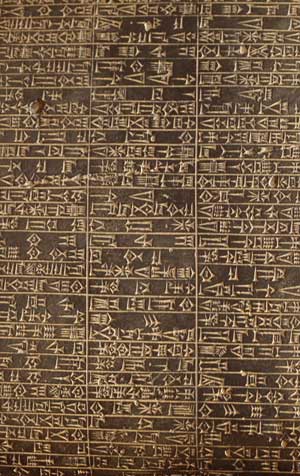


Hammurabi's Code reinforced the principle that the government had a responsibility for what occurred in society.

It said, " To bring about the rule of righteousness in the land, to destroy the wicked and the evil-doers so that the strong should not harm the weak." The Code applied to everyone however, it set different punishments for rich and poor and for men and women. The prologue of the Code set out the goals for this body of law. If he put out the eye of a man’s slave, or break the bone of a man’s slave, he shall pay one-half of its value. If he puts out the eye of a freedman or breaks the bone of a freedman, he shall pay one gold mina. If a man put out the eye of another man, his eye shall be put out. If the woman is at fault, she shall be thrown into the river. If she has been chaste and without fault, even though her husband has neglected or belittled her, she will be held innocent and may return to her father's house.

If a woman hates her husband and says to him, "You cannot be with me," the authorities in her district will investigate the case. If the thief cannot pay, he shall be put to death. If it belonged to a private citizen, he shall repay ten times. If a man has stolen an ox, a sheep, a pig, or a boat that belonged to a temple or palace, he shall repay thirty times its cost. The laws tell us a great deal about the Mesopotamians' beliefs and what they valued. The following are laws from the Code of Hammurabi, adapted from a translation by L. Additionally, the laws were established to protect women and children from unfair treatment. Many of the laws related to the property because of the social classes included merchants, traders, or farmers. King Hammurabi had the Code engraved in stone, and copies were placed all over his Empire. The Code of Hammurabi lists 282 specific laws dealing with everything that affected society, including family relations, business conduct, and crime. Hammurabi's Code helped to unify the diverse groups within his Empire. One of King Hammurabi's most enduring legacy is his uniform Code of laws established for his Empire. King Hammurabi was an able diplomat, administrator, and military leader of a vast empire.
HAMMURABI CODE EYE FOR AN EYE FREE
The Code consisted of 282 laws, with punishments that varied based on social status (slaves, free men, and property owners).The Code of Hammurabi is one of the oldest codes of law from ancient Babylon in Mesopotamia.Describe the significance of Hammurabi’s code.Other forms of codes of law had been in existence in the region around this time, including the Code of Ur-Nammu, king of Ur (2050 BCE), the Laws of Eshnunna (1930 BCE), and the codex of Lipit-Ishtar of Isin (1870 BCE). It is most famous for the “an eye for an eye, a tooth for a tooth” (lex talionis) form of punishment. It consisted of 282 laws, with punishments that varied based on social status (slaves, free men, and property owners). Written in about 1754 BCE by the sixth king of Babylon, Hammurabi, the Code was written on stone steles and clay tablets. The Code of Hammurabi is one of the oldest deciphered writings of length in the world and features a code of law from ancient Babylon in Mesopotamia.


 0 kommentar(er)
0 kommentar(er)
